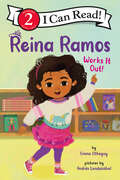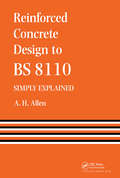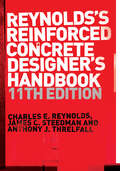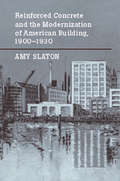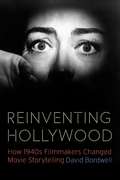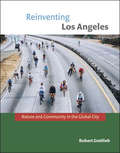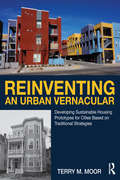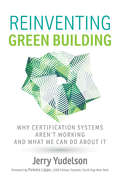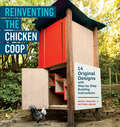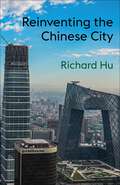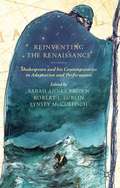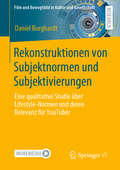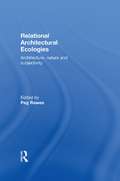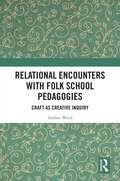- Table View
- List View
Reina Ramos Works It Out (I Can Read Level 2)
by Emma Otheguy"A sparkling tale starring a resilient young protagonist" —Kirkus (starred review)Reina Ramos Works It Out is a Level Two I Can Read story about Reina Ramos, a loyal friend whose high-spirited antics sometimes cause chaos, but who always finds a way to make things right. Perfect for social emotional learning!Reina Ramos is excited about dressing up as Frida Kahlo for the class wax museum. Frida was a strong person like her mami and abuela—plus Reina has the perfect headband for the costume! But when her best friend Nora picks Frida first, Reina doesn’t know what to do. Who will she dress up as now?Reina Ramos Works It Out is a Level Two I Can Read book, geared for kids who read on their own but still need a little help. Whether shared at home or in a classroom, the engaging stories, longer sentences, and language play of Level Two books are proven to help kids take their next steps toward reading success.The story also contains several Spanish words, a glossary, and a list of famous people mentioned in the book.“This level 2 beginning reader contains an engaging, relatable story for emergent readers that features simple text, a sprinkling of Spanish vocabulary, and sweet illustrations on each page.” —Booklist"The Spanish words and positive messages about managing conflict and problem-solving make this a welcome addition to beginning reader collections." —School Library Journal
Reinforced Concrete Design to BS 8110 Simply Explained
by A. AllenThis highly successful book describes the background to the design principles, methods and procedures required in the design process for reinforced concrete structures. The easy to follow style makes it an ideal reference for students and professionals alike.
Reinforced Concrete Designer's Handbook
by Charles E. Reynolds James C. Steedman Anthony J. ThrelfallThis classic and essential work has been thoroughly revised and updated in line with the requirements of new codes and standards which have been introduced in recent years, including the new Eurocode as well as up-to-date British Standards. <P><P> It provides a general introduction along with details of analysis and design of a wide range of structures and examination of design according to British and then European Codes. <P><P> Highly illustrated with numerous line diagrams, tables and worked examples, Reynolds's Reinforced Concrete Designer's Handbook is a unique resource providing comprehensive guidance that enables the engineer to analyze and design reinforced concrete buildings, bridges, retaining walls, and containment structures. <P><P> Written for structural engineers, contractors, consulting engineers, local and health authorities, and utilities, this is also excellent for civil and architecture departments in universities and FE colleges.
Reinforced Concrete and the Modernization of American Building, 1900-1930 (Johns Hopkins Studies in the History of Technology)
by Amy E. SlatonExamining the proliferation of reinforced-concrete construction in the United States after 1900, historian Amy E. Slaton considers how scientific approaches and occupations displaced traditionally skilled labor. The technology of concrete buildings—little studied by historians of engineering, architecture, or industry—offers a remarkable case study in the modernization of American production.The use of concrete brought to construction the new procedures and priorities of mass production. These included a comprehensive application of science to commercial enterprise and vast redistributions of skills, opportunities, credit, and risk in the workplace. Reinforced concrete also changed the American landscape as building buyers embraced the architectural uniformity and simplicity to which the technology was best suited. Based on a wealth of data that includes university curricula, laboratory and company records, organizational proceedings, blueprints, and promotional materials as well as a rich body of physical evidence such as tools, instruments, building materials, and surviving reinforced-concrete buildings, this book tests the thesis that modern mass production in the United States came about not simply in answer to manufacturers' search for profits, but as a result of a complex of occupational and cultural agendas.
Reinforced Concrete from 1906 to Today: Application to the Evaluation of Structures in the Framework of an Asset Management of Civil Engineering Works (ISTE Invoiced)
by Xavier Lauzin Liliya ShakamalovaThe question that regularly arises for the engineer charged with assessing an existing structure that has not deteriorated concerns how to establish the structural diagnosis of the structure. First, it is necessary to ensure that the structure, when subjected to loads and overloads, retains its normal behavior, i.e. conforms to the design predictions. It is essential to understand why and how design and construction rules have evolved, as well as their inaccuracies, shortcomings and even errors. Reinforced Concrete from 1906 to Today details the various calculation codes introduced into French regulations, from the first in 1906 to Eurocode 2, which is currently in force.
Reinforced and Prestressed Concrete: Incorporation Bs 8110 And Microcomputer Applications
by F. K. Kong R. H. EvansThis highly successful textbook has been comprehensively revised for two main reasons: to bring the book up-to-date and make it compatible with BS8110 1985; and to take into account the increasing use made of microcomputers in civil engineering. An important new chapter on microcomputer applications has been added.
Reintegrating Severance: Interdisciplinary Insights on Apple TV’s Dystopian Thriller
by Jennifer Dawes Nora M. IsacoffThis edited collection is an interdisciplinary examination of Apple TV's Severance, in which employees of a biotech firm consent to having their brains severed so that their work selves and non-work selves do not retain each other’s memories. What transpires is a reckoning with the very nature of the self, consciousness, and memory, through a series steeped in explorations of capitalism, social welfare, and bioethics. Chapters in this book examine the popularity and critical acclaim surrounding the show; its retrofuturistic asethetic; its commentary on popular culture and identity; and its engagement with nostalgia, among other topics.
Reintroducing Materials for Sustainable Design: Design Process and Educational Practice
by Mette Bak-AndersenReintroducing Materials for Sustainable Design provides instrumental theory and practical guidance to bring materials back into a central role in the design process and education. To create designs that are sustainable and respond to current environmental, economic and cultural concerns, practitioners and educators require a clear framework for materials use in design and product manufacturing. While much has been written about sustainable design over the last two decades, outlining systems of sustainability and product criteria, to design for material circularity requires a detailed understanding of the physical matter that constitutes products. Designers must not just know of materials but know how to manipulate them and work with them creatively. This book responds to the gap by offering a way to acquire the material knowledge necessary to design physical objects for sustainability. It reinforces the key role and responsibility of designers and encourages designers to take back control over the ideation and manufacturing process. Finally, it discusses the educational practice involved and the potential implications for design education following implementation, addressing didactics, facilities and expertise. This guide is a must-read for designers, educators and researchers engaged in sustainable product design and materials.
Reinventing Brantford: A University Comes Downtown
by Leo GroarkeShort-listed for the 2012 Speaker’s Award One hundred years ago, the City of Brantford advertised itself as the most important manufacturing centre in Canada. During the century that followed, its industrial economy boomed, faltered, and finally collapsed. By the end of the twentieth century, Brantford was known for unemployment, hard luck, and the infamy of having "the worst downtown in Canada." For twenty years the downtown was in steep decline. Significant attempts at urban revival had failed until Wilfrid Laurier University decided to locate a campus in the heart of Brantford’s crumbling city centre. Leo Groarke revisists the grandeur of the city’s past, explores the economic downfall, and tells the story of the arrival of the university, its early struggles, its commitment to historic restoration, and its ultimate success as a catalyst for urban renewal. The compelling story he recounts will engage anyone interested in the plight of the North-American city core and the role that universities and colleges can play in re-establishing downtowns as vibrant centres of historical and contemporary importance.
Reinventing Civil Society: The Emerging Role of Faith-Based Organizations
by Richard C. Hula Laura A. Reese Cynthia Jackson-ElmooreThis guide concentrates on resources that are useful, in an easy-to-use format to enable architects, designers and engineers to access a wealth of knowledge. Information allows users to find, evaluate and contact the resources that can save time and money in day-to-day practice.
Reinventing Hollywood: How 1940s Filmmakers Changed Movie Storytelling
by David BordwellIn the 1940s, American movies changed. Flashbacks began to be used in outrageous, unpredictable ways. Soundtracks flaunted voice-over commentary, and characters might pivot from a scene to address the viewer. Incidents were replayed from different characters’ viewpoints, and sometimes those versions proved to be false. Films now plunged viewers into characters’ memories, dreams, and hallucinations. Some films didn’t have protagonists, while others centered on anti-heroes or psychopaths. Women might be on the verge of madness, and neurotic heroes lurched into violent confrontations. Combining many of these ingredients, a new genre emerged—the psychological thriller, populated by women in peril and innocent bystanders targeted for death. If this sounds like today’s cinema, that’s because it is. In Reinventing Hollywood, David Bordwell examines the full range and depth of trends that crystallized into traditions. He shows how the Christopher Nolans and Quentin Tarantinos of today owe an immense debt to the dynamic, occasionally delirious narrative experiments of the Forties. Through in-depth analyses of films both famous and virtually unknown, from Our Town and All About Eve to Swell Guy and The Guilt of Janet Ames, Bordwell assesses the era’s unique achievements and its legacy for future filmmakers. Reinventing Hollywood is a groundbreaking study of how Hollywood storytelling became a more complex art and essential reading for lovers of popular cinema.
Reinventing Los Angeles: Nature and Community in the Global City (Urban and Industrial Environments)
by Robert GottliebDescribes how water politics, cars and freeways, and immigration and globalization have shaped Los Angeles, and how innovative social movements are working to make a more livable and sustainable city.Los Angeles—the place without a sense of place, famous for sprawl and overdevelopment and defined by its car-clogged freeways—might seem inhospitable to ideas about connecting with nature and community. But in Reinventing Los Angeles, educator and activist Robert Gottlieb describes how imaginative and innovative social movements have coalesced around the issues of water development, cars and freeways, and land use, to create a more livable and sustainable city. Gottlieb traces the emergence of Los Angeles as a global city in the twentieth century and describes its continuing evolution today. He examines the powerful influences of immigration and economic globalization as they intersect with changes in the politics of water, transportation, and land use, and illustrates each of these core concerns with an account of grass roots and activist responses: efforts to reenvision the concrete-bound, fenced-off Los Angeles River as a natural resource; “Arroyofest,” the closing of the Pasadena Freeway for a Sunday of walking and bike riding; and immigrants' initiatives to create urban gardens and connect with their countries of origin. Reinventing Los Angeles is a unique blend of personal narrative (Gottlieb himself participated in several of the grass roots actions described in the book) and historical and theoretical discussion. It provides a road map for a new environmentalism of everyday life, demonstrating the opportunities for renewal in a global city.
Reinventing Modern Architecture in Greece: From Sentimental Topography to Ekistics (Routledge Research in Architecture)
by Marianna CharitonidouThis book examines the connection between the politics of the Marshall Plan and urban planning and identifies the key players, such as the Greek architect and urban planner Constantinos A. Doxiadis and the Italian industrialist Adriano Olivetti. It also explores the architects of the Mataroa mission, who played a vital role in the cross-fertilisation between France and Greece, and the role of travel to Greece for architects during the 19th century.This book delves into the work of Constantinos A. Doxiadis, Adriano Olivetti, Alison and Peter Smithson, Iannis Xenakis, Takis Zenetos, Henri Lefebvre, Cornelius Castoriadis, Aris Konstantinidis, Dimitris Pikionis and others. It sheds light on how Doxiadis introduced “ekistics” as a novel approach to understanding the science of human settlements. This book proposes that the manner in which these aforementioned architects and urban planners addressed the role of technology in everyday life and the relationship between society, history, culture, nature, architecture and urban planning could enrich our ongoing methods and debates on architecture, urban planning, ecology, social equity and democracy.This book is based on extensive archival research and will be of interest to architects, artists, researchers and students and scholars in architecture, architectural history and theory, art, urban sociology, cultural theory, science and technology studies, philosophy, ecology, cybernetics and aesthetics.
Reinventing an Urban Vernacular: Developing Sustainable Housing Prototypes for Cities Based on Traditional Strategies
by Terry MoorWith increasing population and its associated demand on our limited resources, we need to rethink our current strategies for construction of multifamily buildings in urban areas. Reinventing an Urban Vernacular addresses these new demands for smaller and more efficient housing units adapted to local climate. In order to find solutions and to promote better urban communities with an overall environmentally responsible lifestyle, this book examines a wide variety of vernacular building precedents, as they relate to the unique characteristics and demands of six distinctly different regions of the United States. Terry Moor addresses the unique landscape, climate, physical, and social development by analyzing vernacular precedents, and proposing new suggestions for modern needs and expectations. Written for students and architects, planners, and urban designers, Reinventing an Urban Vernacular marries the urban vernacular with ongoing sustainability efforts to produce a unique solution to the housing needs of the changing urban environment.
Reinventing green building
by Jerry YudelsonBuildings and their associated systems are the largest source of greenhouse gases in the world. The 2030 Challenge aims to produce zero net -energy from new North American construction by 2030 while achieving a 50% reduction in carbon emissions from existing buildings. With less than 4% of commercial and residential structures in the U. S. and Canada certified by 2015, we seem destined to fall catastrophically short of this target. Reinventing Green Building combines a unique, insider's critique of the current state of affairs with a potent vision for the future. This highly visual, data-driven analysis brings together the wisdom of today's leading practitioners including: Up-to-date information on green building issues, energy economics and new technology Dramatic new approaches to certification system design and user experience Creative, outside-the-box solutions using the Internet of Things, big data analytics and cloud-based technologies for building management. The green building revolution has failed to fulfill its promise to transform the marketplace in a meaningful way. Smart, simple, and sustainable: Reinventing Green Building presents a new approach to building certification, designed to radically cut costs while dramatically increasing marketplace acceptance integrating true climate mitigation and better building performance.
Reinventing the Automobile: Personal Urban Mobility for the 21st Century (The\mit Press Ser.)
by William J. Mitchell Chris E. Borroni-Bird Lawrence D. BurnsHow to leave behind our unwieldy, gas-guzzling, carbon dioxide–emitting vehicles for cars that are green, smart, connected, and fun. This book provides a long-overdue vision for a new automobile era. The cars we drive today follow the same underlying design principles as the Model Ts of a hundred years ago and the tail-finned sedans of fifty years ago. In the twenty-first century, cars are still made for twentieth-century purposes. They are inefficient for providing personal mobility within cities—where most of the world's people now live. In this pathbreaking book, William Mitchell and two industry experts reimagine the automobile, describing vehicles of the near future that are green, smart, connected, and fun to drive. They roll out four big ideas that will make this both feasible and timely.The fundamental reinvention of the automobile won't be easy, but it is an urgent necessity—to make urban mobility more convenient and sustainable, to make cities more livable, and to help bring the automobile industry out of crisis.
Reinventing the Chicken Coop: 14 Original Designs with Step-by-Step Building Instructions
by Kevin McElroy Matthew WolpeBuild a stylishly modern home for your poultry. Backyard chickens meet contemporary design in this inventive compilation from authors Matthew Wolpe and Kevin McElroy. Reinventing the Chicken Coop presents 14 complete building plans for chicken houses that range from the purely functional to outrageously fabulous, with designs that include water-capturing roofs, built-in composting systems, and modernist architectural details.
Reinventing the Chinese City
by Richard HuSince the late 1970s, China has undergone perhaps the most sweeping process of urbanization ever witnessed. This is typically understood as a story of growth, encompassing rapid development and economic dynamism alongside environmental degradation and social dislocation. However, over the past decade, China’s leaders have claimed that the country’s urbanization has entered a new stage that prioritizes “quality.” What does China’s new urban vision entail, and what does the future hold in store?Richard Hu unpacks recent trends in urban planning and development to explore the making and imagining of the contemporary Chinese city. He focuses on three key concepts—the “green revolution,” “smart city movement,” and “great innovation leap forward”—that have become increasingly influential. Through case studies of Beijing, Hangzhou, and Hefei, Hu analyzes how attempts to achieve greater sustainability, promote data-driven governance, and foster innovation have fared on the ground. He also considers the experimental city Xiong’an in terms of China’s idealized vision of the urban future and investigates how the recent experiences of Hong Kong relate to regional and national development projects.Reinventing the Chinese City provides a careful accounting of the ideas that have dominated urban policy in China since 2010, emphasizing key continuities underlying claims of novelty. Shedding light on the transformations of the Chinese city, this book offers a new perspective on the factors that will shape the trajectory of urbanization in the coming decades.
Reinventing the Renaissance
by Sarah Annes Brown Robert I. Lublin Lynsey MccullochThe plays of Shakespeare and his contemporaries has inspired interpretations in every genre and medium. This book offers perspectives on the ways in which practitioners have used Renaissance drama to address contemporary concerns and reach new audiences. It provides a resource for those interested in the creative reception of Renaissance drama.
Reinventing the Workplace
by John WorthingtonIncorporating a diversity of practices, cultural and organization change, and new building forms, this book provides ideas, inspiration and analysis of the multitude of ways in which an office space can be designed and utilized. Updated to cope with technological advances, as well as including a new series of case studies on recent Australian, North American and Scandinavian experiences, the contributors draw on a wealth and variety of professional experience to present the best and most innovative solutions for today's office - and tomorrow's workplace.
Reinvéntate y vístete como deseas: Aprende a renovarte físicamente alineando tu imagen con tus pensamientos y accio
by Belén NaveránCómo reinventarte físicamente conforme a quién eres en el momento presente. <P><P>El propósito de este libro es ayudar a reinventarse físicamente a quien esté buscando un cambio en su vida, ya sea hombre o mujer, con independencia de su edad. A lo largo de la obra se repasan los diferentes ámbitos que componen nuestra realidad personal y profesional, nuestras actividades y costumbres, etc., con la intención de reflexionar sobre ellos y eliminar todo aquello que ya no nos representa. <P><P>Se trata de renovarnos desde el interior a través de nuestros pensamientos, y guiarnos mediante ciertas pautas y sugerencias para que ese cambio se refleje en nuestro vestuario y en nuestra imagen en general. <P><P>Cada uno de los apartados de este libro es un paso que nos ayudará a convertirnos físicamente en quienes somos en el momento presente e identificarnos con nuestro nuevo yo; y nos facilitará algunas claves para poder transformarnos, siempre que necesitemos un cambio.
Reisterstown
by Gayle Neville BlumBefore it was a colonial village, Reister's Town was home to tribes of the Susquehanna who lived and hunted plentiful wildlife amidst the dense primeval woods. Travelers journeyed on narrow Native American trails from remote areas through what is now Reisterstown while on their way to the nearby bustling harbor in Baltimore Town. Dirt roads afforded a tiresome trip, and a man's throat would easily become parched from the dust. John Reister, an enterprising German immigrant, was one of these early travelers. Reister recognized that the area, only a day's travel from Baltimore, would make an ideal site for an inn where weary travelers could rest and recoup. In 1758, Reister founded the town on 20 acres that the Calverts had granted him. Soon after, in 1768, Daniel Bower, a Revolutionary War colonel, settled on nearby land and built a tavern reputed to have accommodated George Washington. By 1800, Reister's Town was a busy community boasting shops, a tannery, blacksmith, inn, and taverns, which were all vital to the growth of the town and nearby communities.
Rekonstruktionen von Subjektnormen und Subjektivierungen: Eine qualitative Studie über Lifestyle-Normen und deren Relevanz für YouTuber (Film und Bewegtbild in Kultur und Gesellschaft)
by Daniel BurghardtAnhand detaillierter Analysen von YouTube-Videos verdeutlicht das Buch, welch zentrale Rolle Subjektnormen für verschiedene Produzent_innen von Lifestyle-Videos spielen. Hierbei werden sowohl unterschiedliche Normen sichtbar, als auch deren Relationen zum Habitus der Untersuchten, welche sich in Aneignungs-, Passungs- und Spannungsverhältnissen sowie in Widersetzungen ausdrücken. Im Kontext der Subjektivierungsforschung und deren Bezugnahme auf Althusser und Foucault lassen sich jene Ausrichtungen als Subjektivierungen deuten, die mal mehr, mal weniger reflektiert vollzogen werden.
Relational Architectural Ecologies: Architecture, Nature and Subjectivity
by Peg RawesExamining the complex social and material relationships between architecture and ecology which constitute modern cultures, this collection responds to the need to extend architectural thinking about ecology beyond current design literatures. This book shows how the ‘habitats’, ‘natural milieus’, ‘places’ or ‘shelters’ that construct architectural ecologies are composed of complex and dynamic material, spatial, social, political, economic and ecological concerns. With contributions from a range of leading international experts and academics in architecture, art, anthropology, philosophy, feminist theory, law, medicine and political science, this volume offers professionals and researchers engaged in the social and cultural biodiversity of built environments, new interdisciplinary perspectives on the relational and architectural ecologies which are required for dealing with the complex issues of sustainable human habitation and environmental action. The book provides: 16 essays, including two visual essays, by leading international experts and academics from the UK, US, Australia, New Zealand and Europe; including Rosi Braidotti, Lorraine Code, Verena Andermatt Conley and Elizabeth Grosz A clear structure: divided into 5 parts addressing bio-political ecologies and architectures; uncertain, anxious and damaged ecologies; economics, land and consumption; biological and medical architectural ecologies; relational ecological practices and architectures An exploration of the relations between human and political life An examination of issues such as climate change, social and environmental well-being, land and consumption, economically damaging global approaches to design, community ecologies and future architectural practice.
Relational Encounters with Folk School Pedagogies: Craft as Creative Inquiry
by Amber WardThis book explores folk school pedagogies through craft as creative inquiry. Using a study at and inspired by The Clearing Folk School, a continuing education institution located at the northern tip of the Door County Peninsula, Wisconsin, United States, it explores the crafting of teaching practices from learners, educators, researchers, artists, animals, land, plants, and sky. The author shows how such practices function as an antidote to contemporary anthropocentric, environmental, and political crises. Contributing to conversations in posthuman ethics, it engages folk school pedagogies between humans and more-than-humans through thinking, writing, folding, interviewing, collaging, and journaling. Exploring craft as creative inquiry that works against conventional methods of and assumptions about research, it ultimately investigates the utility of folk school teaching practices that highlight relations between beings and things as kin. As such, it will appeal to scholars, researchers, faculty, and postgraduate students working across research methods, arts education, and educational philosophy by taking seriously relational pedagogies and perspectives through craft as creative inquiry.
